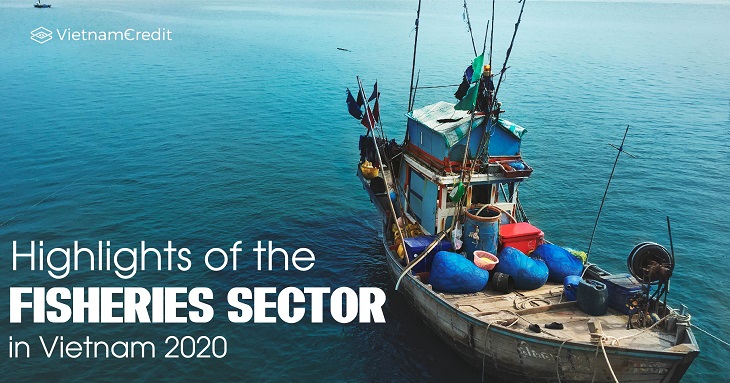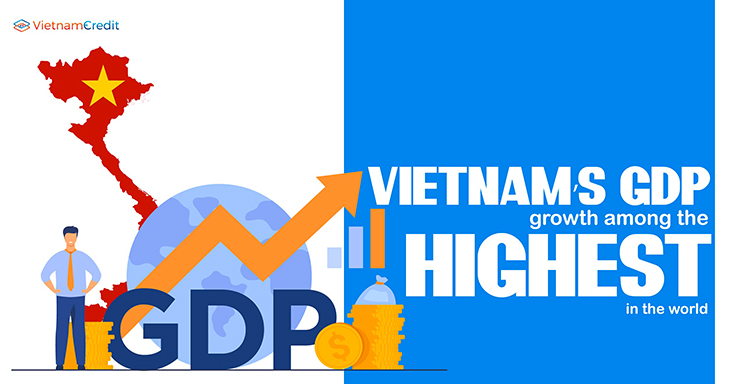The Covid-19 pandemic spread rapidly across the globe, seriously affecting many commodities in Vietnam, especially aquatic products.
I. Enterprise structure and labor in fisheries
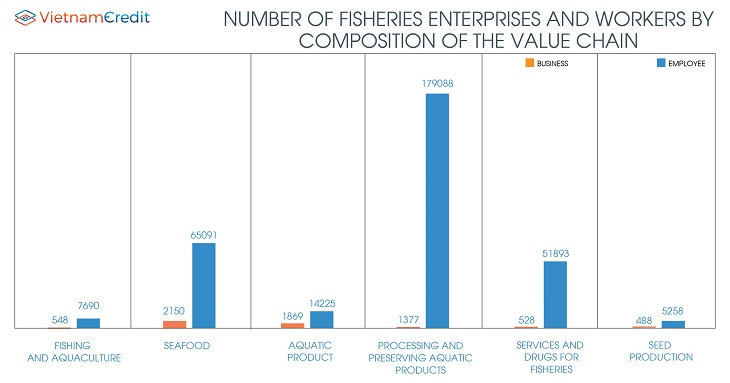
It can be said that seafood processing is one of the important economic sectors in Vietnam which helps create jobs for many employees in the fisheries industry today. According to the statistics of Vietnam Credit Ratings (VietnamCredit), there are currently more than 12.7 thousand businesses operating in the fields related to the fisheries sector. In particular, most of the businesses are exploiting and aquaculture with the number of over 6,000 enterprises. Furthermore, until now, there have been 636 seafood processing and exporting enterprises in the country with food safety and hygiene certification and export conditions and markets. The number of factories and technologies for processing aquatic products is increasing. There are more than 600 industrial-scale processing enterprises with a capacity of 3 million tons/year out of more than 1,300 seafood processing establishments with registered business and production. There are 300 seafood processing factories concentrated in the Mekong River Delta in areas of shrimp, pangasius, and seafood raw materials. The amount of seafood raw materials being processed is 70%, equivalent to over 4 million tons. The average processing capacity used is 65%.
The seafood processing factories are invested to improve their capacity, modern processing technologies, and advanced quality management skills to meet the requirements of countries in the world. The level, technology of processing, and food hygiene and safety in Vietnam have accordingly been improved. Most seafood processing facilities meet the world's advanced processing technology and quality management standards, so industrial-scale seafood processing establishments meet the standards on food hygiene and safety. products, meet the requirements of markets around the world.
Although the seafood processing and export sector has just over 1.3 thousand operating enterprises, this area has the highest number of concentrated workers with nearly 180 thousand people. Fishing and aquaculture are also important economic sectors, attracting over 100 thousand workers nationwide.
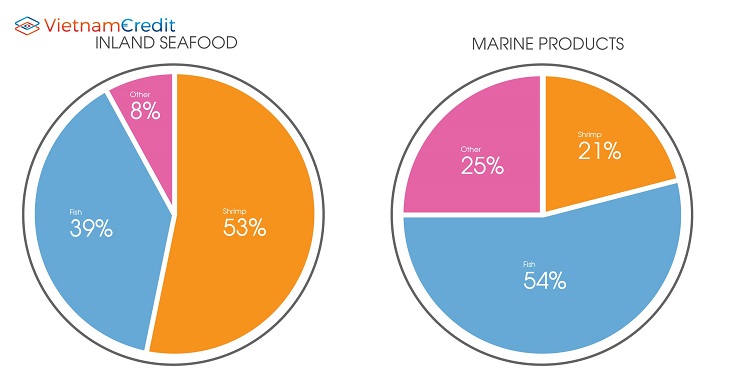
In the current fishery sector, shrimp and fish are considered to be the two most popular commodities. Specifically, in the domestic aquaculture industry, the number of shrimp producing enterprises accounts for more than 50%, the whole farming production accounts for nearly 40%. Besides, for the marine aquaculture industry, the number of enterprises operating in the field is increasing rapidly, by the first quarter of 2020, there were nearly 140 enterprises.
-
With shrimp products, in recent years, the area and output of shrimp farming are constantly increasing, by 2020, the area of shrimp farming of all kinds of the country is estimated to be 720 thousand hectares, an increase of 5.4% compared to 2019. The total production of brackish shrimp is estimated at 745 thousand tons, an increase of 9% compared to 2019. In particular, the production of black tiger shrimp is estimated at 275 thousand tons, an increase of 5.3%, and the production of white leg shrimp is estimated at 475 thousand tons, an increase of 11.2% compared to 2019. Besides, there are about 160 enterprises participating in shrimp processing and exporting, focusing mainly in the Central and South Central region (Khanh Hoa, Phu Yen, and Ninh Thuan). , Ba Ria - Vung Tau ...), Mekong Delta (Long An, Tien Giang, Ben Tre, Tra Vinh, Soc Trang, Ca Mau, Kien Giang), with a total processing capacity of nearly 1 million tons of products. /year. Regarding export markets, in 2019, Vietnam exported shrimp to 97 markets, with a total value of 3.6 billion USD, some of Vietnam's main markets are: EU, Japan, USA, China. Korea, Korea, Canada, Australia, ASEAN, Taiwan, and Switzerland, accounting for 95.9% of Vietnam's total shrimp export value.
-
With fish products, Pangasius is the most consumed product. Over the past years, the Pangasius industry has grown rapidly, making great contributions to the development of the fisheries sector in general as well as to the socio-economic development of the Mekong Delta region in particular. In just a short time, the raising area increased over 10 times, the output reached over 1.4 million tons. This is an important economic sector, attracting over 200,000 employees, more than 70 establishments processing frozen Pangasius fillet. Commercial pangasius production increased dramatically, from 23,250 tons in 1997 to 1,150,500 tons in 2013, an increase of more than 50 times. According to the estimate of the General Department of Fisheries, in 2020, the area of farming pangasius in the whole Mekong Delta region will reach 5,400 hectares (an increase of 3.3% compared to 2017), the output will reach 1.42 million tons, an increase of 8,4% compared to 2019. In 2019, localities have replaced 30 thousand flocks of breeding broodstock have been strengthened, so the quality of pangasius breeding has been gradually improved, operating. hatchery production and commercial pangasius farming have basically been controlled. Promoting the implementation of 3-level pangasius production projects in the Mekong Delta provinces and organizing the 3-level pangasius production association has initially brought about good results. Moreover, 2019 marked the spectacular development of pangasius export activities, from a turnover of $1.78 billion in 2018 to a record high of $2.26 billion, while during the past 5 years, Pangasius export is only around $1.5-1.8 billion
However, the structure of the fishing and aquaculture industry has profound differences. The number of enterprises participating in the fishing industry accounts for only 14% of the total number of businesses with only 17% of the labor in the industry. Direct labor in the fishing and aquaculture industry currently operates individually and without the management of enterprises. Therefore, the fishing industry in Vietnam has not had the active participation of businesses. Moreover, enterprises in the aquaculture industry are currently facing the problem of shortage of technical labor, especially in the aquatic seed production industry is also the main reason that hinders the development of the fishery in the future.
II. Some other key figures of the industry
-
The activities of aquatic product production and inland aquatic product processing have had a positive change. Fishery production from fishing activities has been on a declining growth rate since 2016, only increasing by 4.54% in 2019, due to the decline in natural fishery resources as well as limitations in fishing methods and techniques. Seafood products processed to serve the domestic needs are increasingly diverse in types and quality, improved in value over output, and the growth rate of value is greater than 10% per year. However, seafood processing for domestic consumption still has many shortcomings related to production processes and food hygiene and safety compared to processing sea for export. Currently, seafood processing enterprises for export have combined flexibly with processing for domestic consumption, creating a structural shift to meet the needs of the domestic market.
-
Import and export activities
+ The value of seafood exports in Q1 / 2020 plummeted, especially in major markets adversely affected by Covid-19. In the first 3 months of this year, it reached more than $1.61 billion, down 9.7% over the same period in 2019.
+ Seafood exports to Japan and the United States increased slightly, while the export value to the remaining two main markets, China and the EU, dropped sharply compared to 2019. Specifically, exports to the Chinese market decreased by 27% over the same period in 2019.
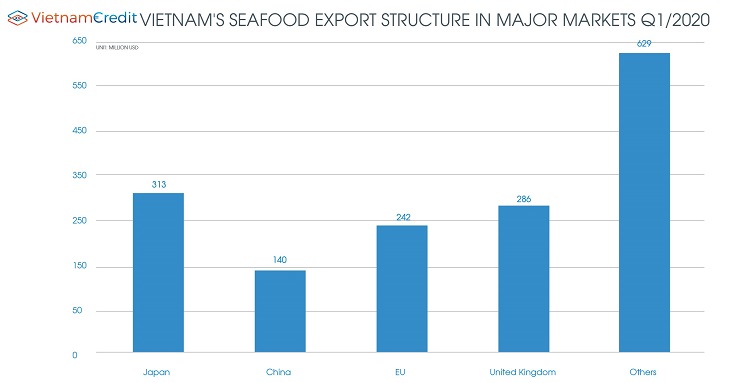
+ The structure of export products is diverse but the value is not high. At present, shrimp, pangasius, yellow-tail catfish, frozen and tuna fish are some of the key export items of Vietnam. Most of the products have higher output growth in value, reflecting the export prices of products on the market that are detrimental to Vietnam's seafood industry.
The industry average is the index calculated by VietnamCredit since 2009 with the goal of building a basis to evaluate and compare the performance of enterprises in the same industry. VietNamCredit has aggregated data from financial statements of more than 160 typical businesses operating in the fisheries sector in Vietnam. Although VietnamCredit has investigated, appraised, and ranked businesses as accurately as possible, however, due to the lack of some data in the financial statements of these companies, the industry average will be affected.
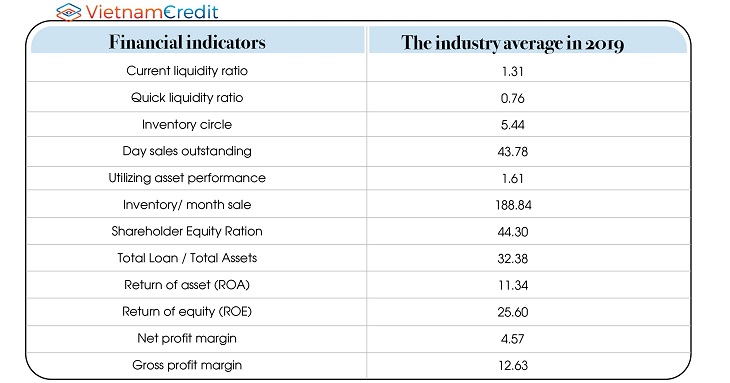
The fisheries sector average indicators in 2019
>> Overview of Vietnam's Fishing Industry
Complied by Vietnam Credit

